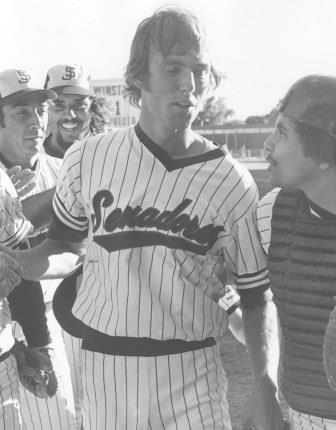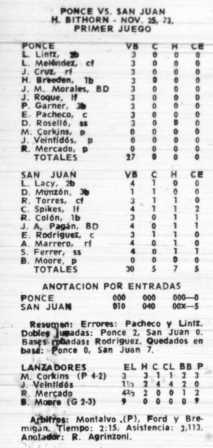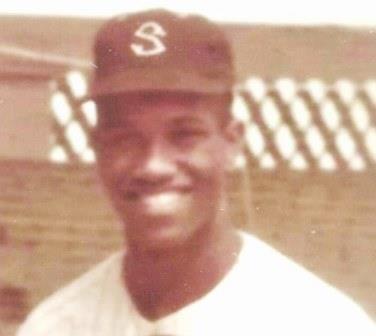Balor Moore was born in Smithville, Texas, about 30 miles south of Austin, on January 25, 1951. He moved to Deer Park, Texas, some 18 miles southeast of Houston, 12 years later. Moore became the first player drafted by the expansion Montreal Expo, June 1969 MLB draft, and 22nd overall pick. He pitched for the Expos, California Angels and Toronto Blue Jays between 1970-and-1980. So why does Puerto Rico still hold his most cherished professional baseball memory?
The 1973-74 San Juan Senators had a Sunday, November 25, 1973 doubleheader versus the Ponce Lions, at Hiram Bithorn Stadium, home of the Senators and Santurce Crabbers. Balor Moore was scheduled to pitch the first game—a nine-inning one. (The second contest was seven innings.) But Moore was under the weather (no pun intended) in the beautiful Caribbean city of San Juan. “I threw up (no pun intended) all Saturday night,” recalled Moore. “I was on the toilet…sick all of Saturday and couldn’t eat.” Junior Gilliam (San Juan’s manager) told Moore: “You look horrible.” But Moore convinced Gilliam he would “be OK, one inning at a time.”
Moore’s pitches were not sharp warming up in the bullpen, per Eliseo “Ellie” Rodríguez, who caught the nine-inning masterpiece. “Balor was not throwing that hard,” said Rodríguez. “I was hoping he could throw a change-up, but Moore was really a ‘two-pitch’ pitcher—fastball-curve.”
Moore put a towel over his head in the dugout after retiring the first three Ponce hitters—2B Larry Lintz, a teammate with the 1973 Montreal Expos; LF Luis “Torito” Meléndez; and RF José “Cheo” Cruz, Ponce’s best hitter with a .341 BA, six HR and 38 RBIs. Moore continued his nice work retiring 1B Hal Breeden, DH José Manuel Morales and RF Jorge Roque in the second; then, disposing of 3B Phil Garner, catcher Edwin Pacheco and SS David Roselló in the third.
By the time Moore took the mound in the sixth, San Juan had a 5-0 lead, thanks to LF Charlie Spikes’ two RBIs, plus RBIs from DH José Antonio Pagán, 1B Raúl “Boogie” Colón and SS Sergio “Cuchito” Ferrer. Moore continued coasting, but pointed out in a September 4, 2019 phone interview that José Cruz hit a “long foul ball” which Cruz—who now resides in Houston, Texas—told Moore he (Cruz) thought was “fair,” but Moore, half-jokingly, replied: “It will always be foul!” In the top of the seventh, Larry Lintz had a 3-and-0 count, but Moore was able to retire his Expos teammate.

The ninth inning was uneventful. Moore fondly remembered Phil Garner, with an ear-to-ear grin, leading off that frame. Garner hit .285 (47 hits/165 AB) for the 1973-74 Ponce Lions, but Moore induced him to fly out to LF Charlie Spikes. Edwin Pacheco struck out—Moore’s ninth strikeout—before David Roselló flied out to RF Angel Marrero Cantres, a reserve, who only had 65 AB in the 70-game season. Scorekeeper Roberto Agrinzoni gave Moore a copy of the historic scorecard. The game lasted two hours and 15 minutes. José (Joe) Enrique Montalvo was the home plate umpire. Dale Ford (1B) and Nick Bremigan were the other two umpires, in a game where Moore threw only 81 pitches—72 fastballs (88.9 percent) and nine curves (11.1 percent).
Home plate umpire Montalvo was someone I first met in April-May 1970, when he umpired some of my high school baseball games at Barbosa Park, in Santurce’s Ocean Park section. In mid-May 1970 I pitched a seven-inning win against our arch-rival with Montalvo behind the plate. He was completely bilingual, having grown up in New York City with parents from
Puerto Rico. Montalvo, a good and fair umpire, had a distinguished Puerto Rico Winter League career as a catcher for the San Juan Senators. Nino Escalera, Montalvo’s San Juan teammate, told the author Montalvo “was a tall [6’4”] and very good defensive catcher.”

Dale Ford recalled how competitive the Puerto Rico Winter League was in 1973-74 and 1974-75, the two seasons he umpired on the Island, during our 1993 phone interview. Ford noted: “It’s better baseball than you’ve worked before you get there (Puerto Rico). It’s just a steppingstone to the big leagues, in my opinion—designed for experience, and you need all the experience you can get, especially in argument situations. You had guys like Frank Robinson, who managed Santurce. Those situations helped; he’s a competitor, I’ll tell you that.”
Moore might run into Frank Robinson at Rudy’s 10th Inning Lounge, located near Loiza Street, in the Condado section. They served delicious hamburgers, other menu items and drinks. The proprietor was Rudy Hernández, the first Dominican-born baseball pitcher to play MLB—with the 1960 Washington Senators. His July 3, 1960 AL debut preceded Juan Marichal’s NL debut with San Francisco by 16 days. Milton Ramírez, a Santurce shortstop in the early 1970s, recalled some of the team’s Native players would join Frank Robinson and imported (Stateside) players at Rudy’s.
The 1973-74 San Juan Senators finished 36-34 (third-place) with Junior Gilliam as manager. “All I knew about Gilliam at the time was that he played 2B for the Dodgers and hit behind Maury Wills,” said Moore. “Gilliam had a habit of taking a pitch so Wills would steal a base.”
Moore (3-9, 3.10 ERA, 96 IP and 75 strikeouts) was plagued by a lack of run support. Tom Walker (10-4, 3.06 ERA); Tom Hilgendorf (9-5, 2.57 ERA); and Orlando Peña (6-2, 2.77 ERA) were San Juan’s other three starters. Chris Chambliss (.362 BA, four HR, and 30 RBIs), Lee Lacy (.278, 3/31) and Charlie Spikes (.280, 7/18) were the team’s best imported hitters. San Juan was eliminated by Caguas (39-31) in the semi-finals, a team featuring talented native players, plus imports such as Jay Johnstone, Mike Schmidt and Gary Carter.
Mike Schmidt was Moore’s nemesis since mid-September 1972, when Schmidt’s three-run HR off Moore gave the Phillies a 3-1 win over Montreal on September 16. Moore was working on his third straight NL SHO. He had a 25-inning scoreless streak when Gene Mauch had Moore walk Roger Freed intentionally, with Terry Harmon on third base, and two outs in the home seventh at Philadelphia. Tim Foli had converted a double play by catching a line drive and throwing to Ron Fairly at 1B to double up Greg Luzinski, prior to Freed stepping in. Moore noted that Tim McCarver—the Expos catcher—wanted him to throw a fastball on the outside part of the plate. But Schmidt hit an inside fastball for his game-winning hit.
Tom Walker, in an earlier blog by the author, noted that “the Expos were big on winter ball; they knew it was close to AAA or better.” [Montreal] GM Jim Fanning and [Expos] manager Gene Mauch kept up with winter ball…how we were doing.” Moore recalled his Expos 1971 AAA team, the Winnipeg Whips, had many older players who were “malcontents, has-beens in a bad environment.” He contrasted this with the expansion Toronto Blue Jays of the late 1970s, who had younger players and “wanted to be there” as opposed to the veteran Montreal players.
By the time Moore married Paula Aucoin in Deer Park, Texas, February 1, 1974, he had pitched 302 innings in less than a year, including: 30 innings for Gene Mauch in spring training 1973; 176.1 IP, 1973 NL season; and the 96 IP for San Juan, including the nine-inning masterpiece. “Terry Humphrey [then a Montreal Expos catcher] was the best man at my wedding,” stated Moore. “Terry still lives in Southern California. He is funny and sarcastic in a different kind of way…quick-witted and well-liked. The Expos gave him a $500 signing bonus and a one-way ticket to spring training in Bradenton, Florida.”
Moore went through a tough stretch from 1974-to-1976. “My arm blows up on me in 1974,” noted Moore. “When you throw 150-to-160 pitches/game, with many walks and strikeouts, coupled with bad mechanics…get a tired arm. It took me three years to back [to MLB].” This was a real challenge for the LHP who had once pitched a strong seven innings for the 1970 Expos in a spring training game against the New York Yankees and their ace—Mel Stottlemyre.
“Don Drysdale [the 1970-71 Montreal Expos broadcaster] was my Montreal mentor,” affirmed Moore. “Mickey Mantle and Whitey Ford were sitting on the New York Yankee bench that [1970] spring training game. I was chewing bubble gum…after the game Mantle and Ford told me to get rid of the bubble gum and wanted to make sure Drysdale did something.” Per Moore, Drysdale said: “I’ll take care of this.” Moore also complimented veteran Ron Fairly from his Montreal days. “Fairly’s locker was next to mine,” said Moore. “He was an ex-Dodger; set a good example by his professionalism…way he dressed.”
The Expos sold Moore to Montreal on June 15, 1975. Shortly thereafter, Moore met with Harry Dalton, the Angels GM; and Nolan Ryan, the star RHP from Alvin, Texas, who was scouted by Red Murff, early-to-mid 1960s, prior to Ryan being drafted by the Mets in 1965, 12th round, with the 226th overall pick. Murff joined the Expos scouting staff in September 1968, and he was the person who scouted and signed Moore for the Montreal organization. “Red Murff followed me since the seventh grade in Deer Park,” said Moore. “He noticed how far I could throw a football. He did the old-fashioned way of scouting—with a stopwatch.”
Don Drysdale—now a California Angels broadcaster, Harry Dalton and Nolan Ryan watched Moore warm up on June 16, 1975, 24 hours after Moore’s sale to the Anaheim-based club. “I hurt,” was all Moore could say after this pitching experience, where his fastball was clocked at 78 MPH on a brand new, state-of-the-art radar gun. (One of Nolan Ryan’s pitches was clocked at 93-94 MPH on this new “device” that same day.) “They [Angels] sent me to Dr. Frank Jobe,” per Moore. “Jobe told me I had a rib broken in three places and my pitching elbow is shot.” Jobe noted he would see Moore in spring training 1976.
Moore worked for UPS the winter of 1975-76 before he had a sub-par (6-12, 5.55 ERA) season for the 1976 El Paso Diablos, Class AA Texas League. He was assigned to Class A Salinas, California League, in 1977, where he showed improvement based on a 2-0 record, 1.69 ERA and 18 strikeouts in 16 IP, with one save. There he developed a friendship with Dickie Thon, an 18-year old prospect from Puerto Rico, who remembered Moore’s 1973-74 season with San Juan. Moore was promoted to Class AAA Salt Lake City (33 games, 4-4, 3.93 ERA, two saves). Then he got the call to join the California Angels. In seven games, including three starts, he was 0-2 with a 3.97 ERA. He enjoyed reuniting with Frank Robinson, hitting coach for the 1977 Angels.
Harry Dalton was a close friend of Hiram Cuevas, GM for the 1977-78 Santurce Crabbers. Dalton recommended Moore to Cuevas, affirming the LHP had overcome adversity and would help Santurce out of the bullpen, and could start, if the situation arose. Moore made Dalton look good by going 7-3 for Santurce with a 2.37 ERA, third-best in the league, behind Scott McGregor (2.18 for Caguas) and Dennis Kinney (2.22 for Ponce). Moore’s 39 strikeouts in 60.2 IP were fine, considering Moore’s injury history and the fact this league was better than Class AAA. Santurce (27-33) finished fifth of six teams and failed to make the playoffs. Jack Krol was Moore’s manager with Santurce. They rode together to home games at Bithorn Stadium. Moore opined that both Krol (1977-78) and Gilliam (1973-74) were “outstanding managers.”
Fourth-place Mayagüez Indians (29-31) qualified for the 1977-78 league playoffs, and eventually won the league title and February 1978 Caribbean Series—the regional round-robin event then featuring the Dominican Republic, Mexico, Puerto Rico and Venezuela. That particular series was hosted by Mexico. Tom Bruno, a Santurce RHP, reinforced Mayagüez in this Series, and won the series-clinching game. Bruno used that winter to impress Krol, his Santurce skipper, a St. Louis Cardinals coach. Moore went home to prepare for spring training with the Angels.
The 1978 California Angels were playing the Los Angeles Dodgers in the final game of their Freeway Series, preceding the MLB season. “I came in and threw a 3-2 slider to Rick Monday, called a ball,” recalled Moore. “Ran into the ump after the game, who told me: ‘I just missed it; will give it to you the rest of the year.’” But Moore was designated for assignment (DFA) right after the game ended. His response to the ump was: “Too late; I’m no longer an Angel.” California sold Moore to the Toronto Blue Jays, April 13, 1978, complying with DFA protocol.
Moore spent nearly three seasons with the Blue Jays, 1978-80, until his release on September 3, 1980. He enjoyed playing for manager Roy Hartsfield, and doubled his MLB service time from three to six years. This enabled him to qualify for an MLB pension, not to mention a monthly Social Security check he receives from having pitched in Canada! Moore had the fortune, or misfortune to some extent, of pitching for the two expansion teams from Canada—Montreal, 1970, 1972-74; and Toronto, 1978-80. His minor league stints included Winnipeg (1970-71), Quebec (1972) and Vancouver (1981). But Moore missed out on a $20,000 bonus in 1980, when the Blue Jays released him before the performance clause for number of games kicked in.
Part of the 1980-81 winter was spent pitching for the Aragua Tigers in Venezuela. But it was a tougher situation than Puerto Rico. Moore was 29 years old and a free agent, without the benefit of having an agent. He and Paula Moore now had two toddlers—son, Baylor, age three; and, daughter Diana, age one. Moore also spent time on the disabled list (DL) since Aragua carried way too many imported pitchers, and it was common practice [in Venezuela] to rotate these imports. Camilo Pascual, Aragua’s pitching coach, threw his famous curve ball during batting practice. Pascual, an international scout for the Oakland A’s, 1982-88, liked Moore’s work ethic and demeanor.
Harry Dalton, now the Milwaukee Brewers GM, gave Moore a 1981 spring training invite. But Moore was sent to AAA Vancouver after allowing a single run in 13 innings. “Rollie Fingers relieved me in my last [spring training] game, after I gave up a hit,” said Moore. “That runner scored…Brewers kept [LHP] Randy Lerch and sent me to Vancouver…pitched well. They later called up Rickey “Buster” Keeton; it took my guts out…could not rebound from that setback.” The Houston Astros contacted Moore, who pitched his final pro innings with the Class AAA Tucson Toros. This was it.
Moore’s “after [baseball] life” includes 36 years as the owner of Brittex International Pipe Supply, Houston, Texas, plus another two years (1981-83) as an employee. “The Pipe Company did not offer me a job [in 1981],” said Moore. “Called them back and said I’ll take the job. Wasn’t that far removed from baseball…had competitive juices flowing. My life AFTER baseball has been awesome; finally had the security I never had in baseball…wasn’t sure if next outing would be my last outing. Only went to spring training a couple of times with a job…”
Balor Moore’s MLB/minor league stats can be accessed at www.baseballreference.com. Puerto Rico Winter League stats (two seasons): 10-12 W-L, 2.81 ERA, 156.2 IP and 114 strikeouts. Venezuelan Winer League stats (one season): 1-2 W-L, 4.43 ERA, 42.2 IP and 19 strikeouts. “The best time in my baseball career was in Puerto Rico—game after my perfect game, [Juan] Beníquez got a hit for Santurce; Frank Robinson was their manager…I close my eyes and smell the nice aroma at the San Juan [now Luis Muñoz Marín] International Airport….San Juan-Santurce rivalry and sellout crowds…” Moore’s nine-inning gem is the ONLY nine-inning perfect game in the 80-year history of the Roberto Clemente Professional Baseball League.
With deep appreciation to Balor Moore for his insights during our September 3-4, 2019 phone interviews. Jorge Colón Delgado furnished the November 25, 1973 box score of Moore’s perfect game. Paul Hartzell (California Angels) and Tom Walker (Montreal Expos and San Juan Senators) provided feedback as teammates of Moore. Thanks to Eliseo Rodríguez, catcher of Moore’s perfect game, for his thoughts; and to Dale Ford, one of three umpires assigned to the November 25, 1973 doubleheader between Ponce and San Juan at Hiram Bithorn Stadium.


Yo asistí a ese juego (perfecto). Estaba, con mi padre, en la primera fila detrás del ‘home plate’. Fue transmitido por el canal 2 (Telemundo).